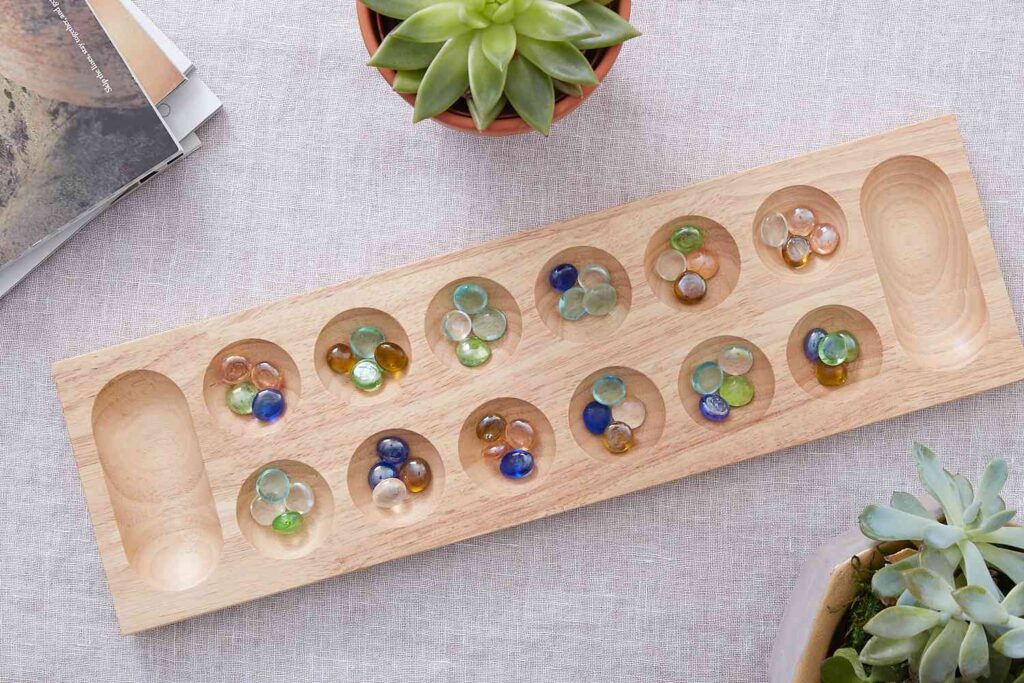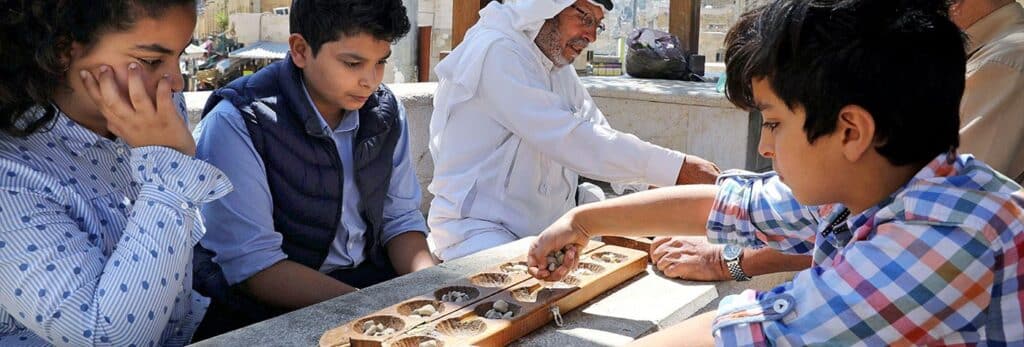Are you curious about Mancala, the ancient board game still popular today? Many initially find the rules tricky, but don’t worry—we’re here to help!
This guide breaks down how to play Mancala in easy steps. We’ll cover the basics, from setting up the board to making your moves. You’ll learn the key rules and some simple tips to get started.
By the end, you’ll be ready to enjoy this fun, strategic game with friends and family. Mancala is great for players of all ages, sharpening your thinking skills while you have a good time.
Ready to learn a new game that’s been loved for thousands of years? Let’s jump into the world of Mancala and get you playing in no time!
Brief History of Mancala

1. Ancient Beginnings
Mancala, a family of counting and strategy games, has roots stretching back thousands of years.
Many think it started in ancient Sumeria and Egypt, where people played games with seeds and stones in small pits.
2. Spreading Across Continents
As time passed, Mancala games spread far and wide. They became popular across Africa and the Middle East, with each region adding its spin to the basic rules. Today, you can find Mancala played in many parts of the world.
3. A Game of Many Names
Different cultures have their versions of Mancala. For example:
- In West Africa, people play a version called Oware
- In East Africa, Bao is a popular form
- The Middle East has its variants, like Mangala
Each type of Mancala has its own unique rules, but they all share the basic idea of moving and capturing pieces.
This variety shows how Mancala has adapted to different cultures while maintaining its core gameplay.
The Objective of The Game

Winning at Mancala
The main goal in Mancala is simple: you want to end up with more stones (or seeds) than your opponent. While the Mancala rules can vary, this core objective stays the same across most versions.
Sowing and Capturing
To win, you’ll use two key actions:
- Sowing: This means picking up all the stones from one pit and dropping them one by one into other pits.
- Capturing: You take stones from your opponent’s side of the board and add them to your collection.
The Basic Idea
Think of Mancala as a game of moving and collecting. You’re trying to move stones around the board in a way that lets you capture more than your opponent. It’s like planting seeds (sowing) and then harvesting them (capturing).
By understanding these basic Mancala rules, you’re ready to start playing. Remember, the exact way you sow and capture might change depending on which version of Mancala you’re playing, but the goal of getting the most stones always stays the same.
Materials Needed

1. The Mancala Board
To play Mancala, you’ll need a board with 14 pits. Here’s what it looks like:
- 12 smaller pits arranged in two rows of six
- 2 larger pits (called “stores” or “Mancalas”) at each end
Don’t have a Mancala board? No problem! You can make your using:
- An empty egg carton (for the 12 smaller pits)
- Two small bowls or cups (for the stores)
2. The Playing Pieces
You’ll need 48 small objects to use as playing pieces. These can be:
- Stones
- Beans
- Marbles
- Seeds
Any small, uniform objects will work. Ensure you have enough for four pieces in each of the 12 smaller pits.
3. Setting Up the Game
Now that you have your board and pieces, here’s how to set up:
- Place the board between the two players, the long side facing each player
- Each player sits facing a row of six small pits
- Put 4 pieces in each of the 12 small pits
- Leave the two larger end pits (stores) empty
Remember, each player “owns” the six pits closest to them and the store on their right. This setup is key to understanding the Mancala rules and gameplay.
With these materials ready, you’re all set to start playing Mancala!
How to Set Up the Game
Setting up your Mancala game is quick and easy. Let’s walk through it step by step.
1. Distributing the Stones
- Take your 48 stones (or seeds or marbles).
- Each player puts 4 stones in each of their 6 pits.
- When you’re done, all 12 small pits should have 4 stones each.
2. Preparing the Stores
The two larger pits at the ends of the board are called “stores” or “Mancalas”. Here’s what to do with them:
- Leave both stores empty at the start of the game.
- Each player will use the store to their right to collect captured stones.
3. Final Check
Before you start playing, make sure:
- All 12 small pits have 4 stones each
- Both stores are empty
- Each player is sitting in front of their row of 6 pits
By following these simple Mancala rules for setup, you’re ready to begin the game. Remember, the goal is to end up with more stones in your store than your opponent. Good luck!
Here’s the revised version of the “Step-by-Step Gameplay” section using H3 headings for better structure:
Step-by-Step Gameplay

1. Deciding the First Player
Before you start playing Mancala, you need to decide who goes first. A simple coin flip or any other random method works well for this. You’re ready to begin the game once you’ve chosen the first player.
2. Making Your Move
On your turn, you’ll start by choosing any non-empty pit on your side of the board. Pick up all the stones from that pit – this is the beginning of your move. Now comes the key part of the Mancala rules: sowing the stones.
3. Sowing the Stones
Moving counter-clockwise around the board, you’ll drop one stone into each pit you pass. When you reach your store (the larger pit on your right), drop a stone there, too. However, when you pass your opponent’s store, skip it and continue to the next pit.
4. Example of a Turn
Let’s walk through an example to make these Mancala rules clearer. Say you choose a pit with four stones. You’d pick up all four, then drop one stone in each of the next four pits, moving counter-clockwise.
You’d drop a stone there if you reach your store during this process. But if you pass your opponent’s store, you’d skip it and move to the next pit.
5. Ending Your Turn
Your turn typically ends when you drop your last stone. At this point, play passes to your opponent, who follows the same process.
By following these steps, you’ll be well on your way to playing Mancala. Remember, the ultimate goal is to collect more stones in your store than your opponent by the end of the game.
Here’s the section on “Special Gameplay Rules” using H3 headings for better structure:
Special Gameplay Rules

1. Free Turns
One of the most exciting Mancala rules involves earning free turns. If the last stone you drop during your turn lands in your store, you get to take another turn right away.
This rule can lead to clever strategic moves as skilled players try to set up multiple turns in a row.
2. Capturing Stones
Capturing stones is a key way to gain an advantage in Mancala. Something special happens if the last stone you drop lands in an empty pit on your side of the board.
You get to capture that stone, plus all the rocks in the pit directly opposite on your opponent’s side. All these captured stones go into your store. This rule can lead to big swings in the game, so always watch for capturing opportunities.
3. Ending the Game
The Mancala game ends when one player clears all the pits on their side of the board. At this point, the other player gets to collect any stones remaining in their pits and add them to their store.
This final collection can sometimes change the game’s outcome so that the last few moves can be crucial.
4. Counting and Winning
Once all stones are in the stores, it’s time to count. The player with the most stones in their store wins the game. If both players have the same number of rocks, it’s a tie.
These endgame Mancala rules add extra excitement as the game draws closer.
Understanding these special rules allows you to develop more advanced strategies and enjoy the full depth of Mancala gameplay.
Remember, practice makes perfect, so don’t be afraid to play often and experiment with different tactics!
Tips and Strategies

1. Maximizing Free Turns
One of the most powerful Mancala rules allows you to take another turn when your last stone lands in your store. To make the most of this:
- Look for moves that end in your store
- Try to keep stones in pits that are a multiple of 7 away from your store
- Chain together multiple free turns for big gains
2. Capturing Opponent’s Stones
Capturing is a key way to get ahead in Mancala. Here’s how to do it effectively:
- Keep track of empty pits on your side
- Look for opportunities to end your turn in these empty pits
- Pay attention to how many stones are in your opponent’s opposite pits
- Aim for big captures to swing the game in your favor
3. Thinking Ahead
Mancala is a game of strategy, so planning is crucial:
- Try to think two or three moves ahead
- Consider how your moves might set up your opponent
- Look for ways to create multiple good options for your next turn
- Be flexible and adjust your strategy based on your opponent’s moves
4. Managing Your Stones
How you distribute your stones can make a big difference:
- Try to keep stones on your side of the board
- Avoid leaving single stones in pits when possible
- Consider keeping some pits empty to limit your opponent’s options
Applying these strategies and paying close attention to the Mancala rules will improve your game and make it fun.
Remember, the best way to get better is through practice, so play often and try out different approaches!
Conclusion
Mancala offers a perfect blend of simplicity and strategy, making it a timeless favorite for players of all ages. By grasping these basic rules and tips, you can start playing and crafting tactics.
Remember the key elements: sowing stones counter-clockwise, capturing your opponent’s pieces, using free turns wisely, and planning.
You’ll uncover the game’s depth and excitement as you play more. Whether on a traditional board or a homemade set, Mancala’s essence remains unchanged – a mix of strategy, foresight, and a touch of luck.
So gather your stones and start playing. With practice, you might become a Mancala master! Most importantly, enjoy the challenge, learn from each game, and appreciate this ancient pastime’s rich history. Happy playing!




